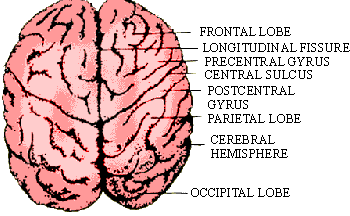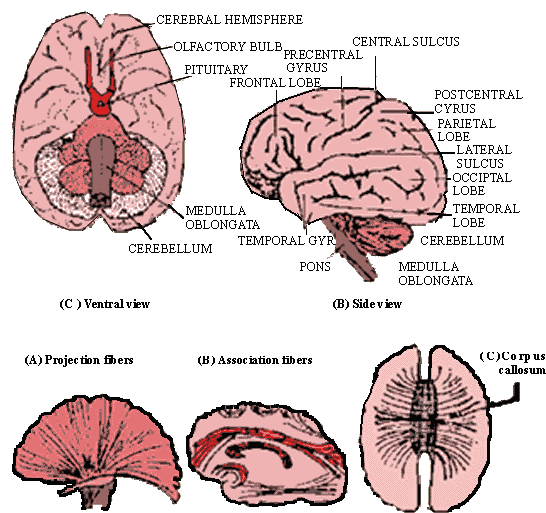The human brain weighs about 1.5kg (average 1350
gms or 3 pounds) and is enclosed in the cranial (skull) cavity.
It is covered by 3 membranes, called meninges. The outer
membrane, called dura mater ("tough mother") is
a tough, protective covering formed of white fibrous tissue the
middle delicate membrane is called arachnoid (web like),
and the inner most transparent membrane is called pia mater ("soft
mother"), containing blood vessels (nutritive in function).
Between the bony and membranous coverings, there is cerebrospinal
fluid, which acts as a protective internal cushion. The bony skull,
meninges and the cerebrospinal fluid protect the brain from external
injury and shocks.
(a) Dorsal view

Figure 23.1 (A) Superior (dorsal) Views of brain
to show cerebral hemisphere, with lobes, furrows and gyri.
1. The Forebrain: It consist of two divisions,
the anterior telencephalon with olfactory lobes, cerebral hemispheres
and the posterior diencephalon with thalamus and hypothalamus.
a) The cerebrum is the largest area of
the brain and is divided by a longitudinal fissure into two cerebral
hemispheres. Each hemisphere consists of a frontal lobe, parital
lobe, occipital lobe and temporal lobe. It shows prominent fissures
(deeper furrows) or sulci (shallow grooves) and gyri or convolutions
(thin ridges between sulci). (Figure23.1 A and B). Structurally,
the hemispheres are made up of 3 portions (i) Cerebral cortex
or grey matter, (ii) Cerebral tracts are bundles of axons
located inside the brain and extend in three directions forming
projection fibers, association fibers, and transverse fibers forming
the corpus callosum (Figure 23.2) (iii) Basal nuclei or
ganglia located deep within the cerebral hemispheres, connected
to each other and with the thalamus and hypothlamus.
CEREBELLUM
b) The thalamus is a large, oval part
located above the midbrain. All sensory impulses (except for olfactory
sensations) entering the cerebrum must pass through the thalamus.

Click here for enlargement
Figure 23.2 Cross connection within the brain